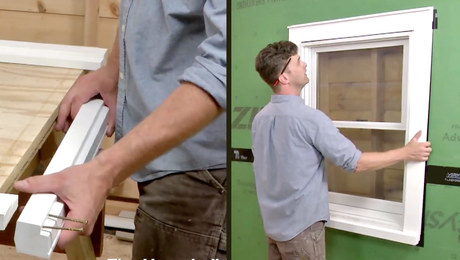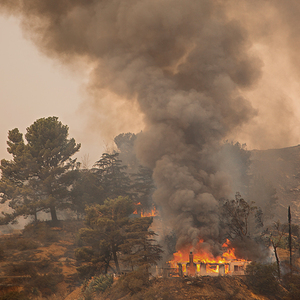Helpful hints on changing a well pump
Well, (pardon the pun) My well just toasted itself about two hours ago, It’s 50+ years old. I think ~100′ deep and is a 110V unit. Anybody have any caveats before I try to pull it up and replace it tomorrow? It appears to be suspended with iron or galvanized 3/4″ pipe.
Edit: I’m planning on replacing every component including the pressure tank. What is more or less the most common and the best (mtrl and size) for the supply pipe coming out of the pump vertically?
Jon
Edited 7/2/2003 11:42:23 PM ET by WorkshopJon



















Replies
"... ~100'... suspended with iron or galvanized 3/4" pipe."
That's gonna be mighty heavy I'm thinking. Be prepared for the weight.
I've pulled a couple of deep well pumps and I found the whole process fairly straight forward. I carefully followed the instructions that came with the Red Jacket pump and (I believe) I got a bit of advice from the plumbing supply where I bought the pump (also checked out the written instructions at Lowes). Took me a day (pretty quick for me!)
You might want to do a search here. Seems like there was a good thread on this a year ago or so.
Another day, another tool.
Does the pump itself sit on top of the well or is it submersed in the water. If it is actually 50 years old, then it undoubtedly sits on top. Pumps of that era were typically "jet" pumps that had two pipes down the well and "foot valve" at the bottom to keep the water in place during the times that the pump was not actually running. These pumps are significantly less efficient than the newer submersible pumps and the lower the water level in the well, the less efficient they become.
If it was just the pump itself that died, then you can probably just get by with replacing the pump/motor unit. The newer jet pumps typically have a plastic housing and are lighter than the old cast iron ones that they replace. Many also typically have a built in pressure regulator instead of the separate one on theolder ones. I think I paid around $240 for the 3/4 hp jet pump I bought about five years ago.
I would assume that restoring water is somewhat of a priority at present, so that will probably influence your decisions.
I just bought a submerssible pump for my 120' well, which typically has the water level about 30' below the surface. I got it on close out for about $180. At 1/2 hp, it is rated to pump more than the 3/4 jet pump. Typically, a submersible pump is rated to deliver over twice as much water as a jet pump for the same horsepower and using the same power. Mine is a two wire submersible but they also make a three wire submersible which requires a separate pump controller adding to the cost. I can't remember under what circumstances the 3-wire is preferable.
The two pipes are necessary with the jet pump because much of the pumped water is diverted down the smaller pipe to push up more water in the larger pipe. I would guess that fifty years ago, galvanized pipe was used, so you have two pipes in probably 20 foot sections, fastened together with the foot valve at the bottom, that you have to lift up and unscrew at the couplings or cut into manageable lengths. I wouldn't try to guess what condition steel pipes would be in that have been submerged in water for fifty years, but I have been told that it might be possible to reuse the pipe with my submersible pump if I want to. I will undoubtedly use a plastic pipe with the submersible, however.
The submersible will require that special electrical wiring and water proof connectors be used to connect to the pump at (near) the bottom of the well. You will also need some type of safety cable (I bought small stainless steel cable for this purpose) or non-degrading rope to raise and lower the pump in the casing.
You will also need a new sanitary cap on the casing as the old one undoubtedly has two holes for the pipe while the new needs a way to seal the single pipe (tubing), electrical cable, and safety cable.
I took a piece of flat bar stock about 6" wide by a foot long and cut a piece of it out just wide enough to slide over the larger pipe so that the steel bar stock then serves to support the pipe assembly by catching the couplings. So I will use my fork lift to raise the pipe (you could possibly use a tripod and a come-along or something similar) and slip the bar stock thingy against the pipe at the top of the well casing and let the pipe back down to rest on the "thingy" while I attempt to unscrew the section of pipe with a couple of 36" pipe wrenches (or maybe one 36" and one 42" that I have). I will have the Sawzall on standby in case it is needed.
Dropping the pump down the casing should be a lot easier. I think it is recommended that you disinfect your well once you have everything buttened up again. Not sure I remember correctly, but I think the procedure is to dump a cup or two of chlorine bleach down the well and then flush it out good.
Some pumps and components are discussed at http://www.epinions.com/Water_Tanks_Pumps although they don't cover what I feel are many of the larger brands.
A manufacturer's website discussing bladder vs diaphram pressure tanks:
http://www.watertanks.com/category/48/
a basic discussion of types of tanks
http://fhaspapp.ittind.com/homeowners/CompressionTank.htm
supplier's discussions of pumps and accessories
http://www.do-it-yourself-pumps.com/you-can-install-a-pump-system.htm
http://www.aermotor.com/faqs/faqs.html
On tank sizing:
http://www1.agric.gov.ab.ca/$department/deptdocs.nsf/all/agdex1136?opendocument
http://www.flexconind.com/html/news.html
http://www.aquascience.net/tanksizing.htm
Have fun...
Edited 7/3/2003 1:08:46 AM ET by CaseyR
This looks like a good thread to ask a question that has been bugging me....
Is there a practical way for a home owner to wash and gravel pack a well. The well is 220 feet deep with the standing water level at 110 feet. It presently has a 240 V. 1-1/2 Hp submersible pump on 1-1/4" PE pipe. When I replace the old pump and pipe 12 years ago it pumped a reliable 12-17 gpm, but has slowly deteriorated to where now I can only run the pump 12-15 minutes before the water level drops to the pump. I believe this is due to sand, of which I get quite a bit. I have a home made centrifugal separator on the outlet which will collect 2 or three cupfuls of sand an hour.
I got a bid on doing this and it was $2700
In my misspent youth I worked on water wells quite a bit.
If you have a pond or swimming pool, its easy.
Flushed 3 YARDS of fine black sand in 6 hours by putting 2" pipe and firehose down 60 ft well and pumping with a 3" $35 harbor freight pump hooked up to '84 crysler engine and run twice overspeed (installed in place of air conditioner compressor) that pumped 740 gal a minute.
Even though the outflow went back to the pond (8 ft deep, 40 ft by 30 ft), the pond was dry after 6 hours.
Your saying you flushed 3 yds of sand out of the well? How did you keep it out of the pool?
Don't have a pool, wonder if a temporary plastic pool would work? What are the implications of contaminating the aquifer?
The "pool", is a pond. At least a hundred yards away.
The water was pumped into the well with enough pressure to carry the sand back up with it, out of the well. But, once the water and sand come out of the top of the well, the water simply ran back downhill to the pond, and left most of the sand on the ground around the top of the well.
If you use a pool, you will run out of water a lost faster than he did, unless there is some system in place to send the water back to the pool.
After you are finished, shock the well with chlorine.
BTW: he also made a nice little tower for the grandkids, above the wellhead. I've been up there. Kinda neat. I'm sure the kids love it. If he had cats, I think they would be up there constantly.
A good heart embiggins even the smallest person.
Quittin' Time
To clean sand out of wells, we welded a 4" loop of 3/4" rod to the inside of a pipe, a little smaller than the well pipe and hook it to the cable. We have two that fit all our wells good enough.
We drop it in the well and it buries itself in the sand. We pull it up and knock the sand off and drop it again and again until we have the depth we want clean.
The wet sand stays in the pipe's end as you are bringing it up.
To pull wells, we made, out of 3/4" or 1" square rod, a "hand" to fit each pipe's size we use. It looks like a 1' long handle with a bend to fit the pipe under the coupling. That bend is deeper than the pipe's diameter and a little open on the end so as to get it around the pipe quickly.
We put it there as the coupling shows and let the pipes down on it so it sits on the edge of the casing and then unscrew the upper pipe and laid it out. Our well pipes are 21' long.
Do be very careful, as to fish anything (like the pipes or pump) dropped in the well is very tricky. Some wells have been ruined by that.
Just an update as to how the project went. The well turned out to be 90" deep and was suspended with 1" galvanized pipe. The original 110V pump was wired (just two wires) with #10 below the cap and #14 above. Pulling it up was a major chore, and after getting it up ~50', I decided to SawzAll all of it in 5" sections(the sections were too corroded to unscrew). It got jammed 3/4 of the way up, but tugging AND twisting got it by that section. At the last 20' my clamp let go due to vibrations from the cutting and the pump dropped almost to the bottom, but I was able to grab the power line in time and it held to pull it up with.
Dropping it all back in with new pipe only took about an hour and a half with virtually no problems except a nasty storm came through just prior to dropping it in (rotating clouds and all). It appears to be now working fine. It was replaced with a 3 (4 with ground) wire 220V pump with is much quieter and powerful than the one it replaced. I added another 10PSI to the system to help with showers on the second floor.
I include some pics.
Jon
Forgot this one.
Jon
"If it is actually 50 years old, then it undoubtedly sits on top. Pumps of that era were typically "jet" pumps..."
Casey,
I'm pretty sure it is a submersible pump. Though the regulator does sit on top of the well. It is possible the well is deeper than I thought.
My estimate is based on the fact that I can lift the pump and pipe up slightly with a crowbar prying on the well cap. I guess there could be water displacing the weight of the assembly though.
I have a 2 ton engine hoist I plan on pulling it with. Any thoughts on how the "pro's" clamp to the pipe as it is raised?
Jon
Hi, Jon
If there is one pipe going down the casing you have a submersible pump setup. Two is a jet pump.
To get the pump out you should use at least 2, better 3 RISER CLAMPS that are attached to the pipe. They are switched to renew the purchase on the pipe as you raise it. The lowest is reclamped to the pipe to allow the pipe to be supported by the well casing. Just keep switching clamps until you get it all up.
Use heavy gauge flexible coil plastic 1" pipe to reinstall the new pump. Junk the old galvinized. tape the wire to the pipe enough to prevent the well sides from rubbing the wire. It's a good idea to attach a safety line to the pump just in case somehow the pump ends up in the well bottom with no pipe attached. You can use stainless cable or 5/16" or 3/8" polyetehylene rope for this purpose. Unless the well is REALLY deep you should be able to lower it with the help of a friend or two without the hoist.
To re-install use SNUBBERS which are heavy plastic or rubber discs that go around the pipe and contact the well walls- prevents the torqueing that occurs when the pump starts. figure on one every 20' or so.
You should be able to get the stuff at a plumbing supply. I wouldn't hold out much hope of getting the stuff at a big box store. you could probably bring a copy of this e-mail to avoid translation issues at the plumbing supply.
Hope this helps!
(:-)
Windy Wood
From the Helderberg Mountains
Ok.
It's 3:00pm day before the Forth of July and I just got done yanking my well pump. 90' deep, mfr 11/64. I have to get the pump and supplies tonight before all the stores close for the holiday. So, my immediate question is... is a 1" copper line (type M or K) OK to use for the supply line off the pump. It had 1" galvanized before. I'm going to try to research this before I head out, but if anybody knows, please reply ASAP.
Edit: the well case is 7.5" which I have been told is not a standard size.
Thanks all
Jon
Edited 7/3/2003 4:03:19 PM ET by WorkshopJon
Stick with galvanized in my opinion. If it lasted that long, why mess with copper. Plus, the well pump does tend to put some torqe on startup. Galvanized is cheaper and so are the threaded fittings. But 20-21'lenghts of pipe if you can find them.
Migraine,
Just curious if you (or anybody else for that matter) knows if the start-up torque tightens or loosens the fittings. ie. if I use teflon tape, should I tighten them real tight, not use it at all and use tread compound? I'm currently planning on going with gavl. 'cause that's all I can get tonite.
Jon
The well guys around here use a thread compoung(paste) and the do tighten them up. Don't rely on the torqu of the pump tightening it up for you. My 2h.p. pump has been in for almost 9 years and I have never had to have it pulled(yet). Hole is 884' deep and the pump is set at about 770-800' deep. If you well is starting to dry up, I suggest you go with a well controller that will turn of the pump when the pump starts sucking air. They way these things work is that the wire for the pump are wrapped around a ring inside the control box. This ring senses the inductance of the power(amps) that is flowing to the motor. When the inductance decreases, the controller senses it and then shuts the pump off. It then waits for a period of time and attemps to turn the pump back on. If it goes throough the process again, the controller wil shut of and this time it will wait longer before cycling back on. These controllers are not Cheap(being only relative to the cost of a new pump and labor to replace it) but worth the money. As stated before in a previos post, buy the warranty for the pump. Be CAREFUL you don't drop that new pump to the bottom. My well guy said that the is the second worst thing that can happen in his business. The worst is having the drill head drop to the bottom. :0(
Hope this helps. Enjoy your Holiday, even though it seems that you will be working on your well tomorrow.
WSJ, what I have seen used by the Pump guys, to hold the Galvanized Pipe, is basically a chunck of steel the size of a dinner plate, with a slot cut to the size of the OD of the Pipe. They lift the pipe with their boom truck, as soon as the coupling appears, they slide the Plate under it, two pipe wrentches, one on the coupling,and one on the raised pipe. To compliment the "dinner plate" is a stubb/nipple, which engages to the 20' sections of pipe. Also, as someone else reccommended, please go with the "pump saver". The last one I had put in "cost" me $75.00, plus the labor. Best of Luck, and empty those shirt pockets,, Jim J
I have 2 wells on my propetry(2 1/2 acres) one is 35' deep, the OTHER is 884',(yes, I'm not drunk-or am I ?-it really is 884' deep) and my 884' deep well does 7.7 gal per minute( what do you expect from SoCal? Were a fricken desert out here!). Have a well contractor replace the pump and BUY the extendednd warranty for about a few hundred dolars. I beliefe that Grundfos(sp?) has a warrany that covers pulling and replacing it. Could you imagine what it would cost to replace mine? (2 hp pump). these guys know the stuff. Ever heard of a guy who drupped the pump to the bottom of a well when trying to do on his own?(not me) I have and it cost more than a simple service call. call Emil at L.O Lunch Quality Wells and Pumps. Mybe he'll fly out there to hepl you. Don't be surprized if he does, It'95-100 degrees out here right now and getting alot worse ever day.
After reading this post, I must confesss that I have Had 3 double margaritas and I'm feeling noooo pain.(on the rocks, of course. frozen are for sissies) My back fells alot better now!